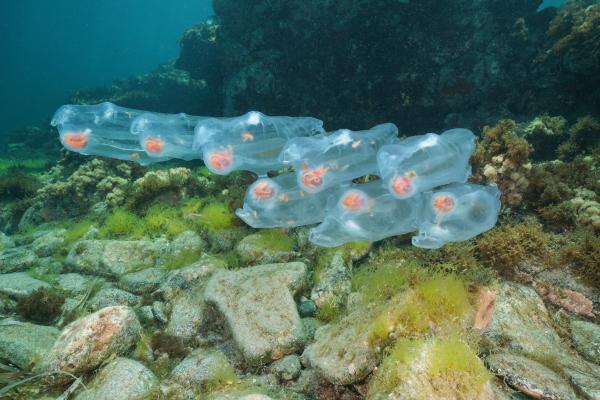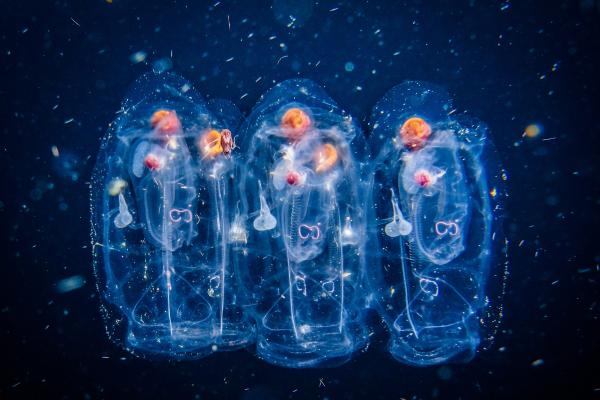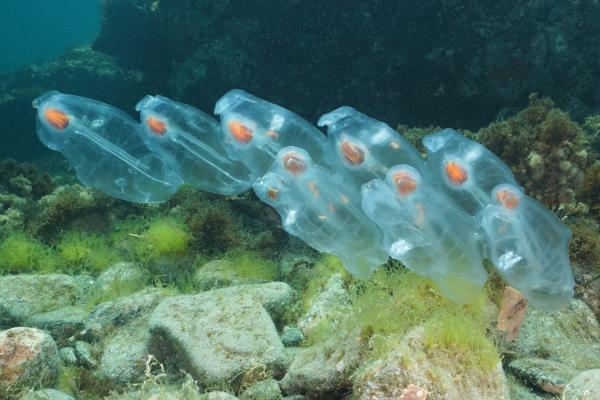Salps (family Salpidae), also known as barrel-shaped tunicates or pelagic tunicates, are fascinating aquarium/52-marine-animals.html">marine animals that drift freely either alone or in extensive colonies in the open ocean. Their bodies are gelatinous and almost completely transparent, making them nearly invisible at the water’s surface. Belonging to the phylum Chordata (subphylum Tunicata, class Thaliacea), salps play a vital role in the marine ecosystem, particularly in the global carbon cycle, due to their ability to capture and transport carbon dioxide.

Salps are tunicate animals that live in the pelagic zones of nearly all the world’s oceans. The term "tunicate" refers to their tough outer “tunic,” a cellulose covering that provides both protection and structure. While salps are chordates, they only exhibit key chordate characteristics—such as a notochord and a dorsal nerve cord—during their larval stage. After metamorphosis into adults, most of these features are lost or highly reduced.

Barrel-shaped, transparent, gelatinous bodies ranging in size from a few millimeters to several centimeters.
Widely distributed in tropical, temperate, and cold oceanic regions, typically in open pelagic waters.
Simple nervous system, with a neural ganglion near the anterior and a horseshoe-shaped “eye” structure.
Two main body openings: an oral siphon (for drawing water in) and an atrial siphon (for expelling water).
Muscular bands in the mantle, whose number and arrangement vary by species, enabling jet propulsion movement.
A coiled digestive tract forming a visible “nucleus” inside the body.
Circulatory system consists of a heart and two main vessels.
Locomotion via jet propulsion: salps contract their body wall to expel water and move efficiently.
Herbivorous filter feeders: they pump water through their gelatinous bodies, trapping phytoplankton with internal mucus nets.
Population density fluctuates with phytoplankton abundance; can rapidly form dense swarms when food is plentiful.
Complex life cycle with alternation of generations—solitary (oozooid) and aggregate (blastozooid) forms.
Hermaphroditic reproduction is common, with both self-fertilization and cross-fertilization occurring.
Bioluminescence: some species can emit light, especially in their colonial forms.
Important prey for pelagic predators such as fish and sea turtles.
Efficient carbon pumps: by capturing carbon-rich particles and sinking them to deep ocean layers, salps help mitigate climate change.
Vectors for marine toxins: by consuming toxic phytoplankton, they can transfer toxins to higher trophic levels.

Salpa fusiformis
Also known as the common salp, this cosmopolitan species has a spindle or barrel-shaped body. It ascends to the surface to feed at night.
Cyclosalpa pinnata
Has an elongated, barrel-like body; colonial forms are thicker and can emit light.
Thalia democratica
Transparent, thick tunic; widely distributed; solitary forms are about 15 mm long, with compact digestive nuclei.
Weelia cylindrica
Cylindrical shape with 8-9 muscle bands; aggregate forms are oval, with dorsal openings.
Pegea confoederata
Found in warm and temperate seas; solitary forms can reach up to 12 cm, aggregate forms up to 15 cm.
Salps are often mistaken for jellyfish due to their appearance, but they are completely harmless to humans. They lack stinging cells and venom. Even if you encounter salps while swimming or diving, they pose no risk.

Salps are more than just ocean drifters. As vital contributors to the global carbon cycle, they help transport carbon to the deep sea and support marine food webs. Their remarkable transparency and colonial life cycles make them a unique topic of study for marine biologists. Learning about salps not only deepens our understanding of ocean biodiversity but also highlights the intricate connections between marine life and the health of our planet.
Bibliography
Galindo, J. E. H., Hernando, J. M., Silva, A. B., Martínez, S. G. K., Mendoza, A., & Vázquez, M. D. C. A. P. (2015). Salps (Thaliacea: Salpidae) as potential vectors of saxitoxin between dinoflagellates and sea turtles. Available from: file:///C:/Users/Usuario/Downloads/Herrera-Galindoetal.2015SalpascomovectorestoxinasyTM.pdf
Hickman, C. P., Roberts, L. S., & Larson, A. (1994). Zoology: Integral Principles.
Fagetti, E. (1959). Salps collected off the central and northern coasts of Chile.
animal tags: Salps
We created this article in conjunction with AI technology, then made sure it was fact-checked and edited by a Animals Top editor.